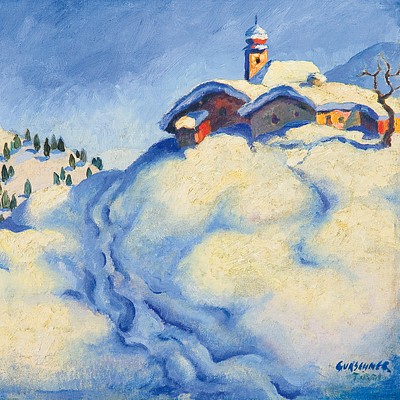ALBERT PARIS GUETERSLOH* (Vienna 1887 - 1973 Baden)
Lot 150
Estimate:
EUR€25,000 - EUR€45,000
$25,773.20 - $46,391.75
Absentee vs Live bid
Two ways to bid:
- Leave a max absentee bid and the platform will bid on your behalf up to your maximum bid during the live auction.
- Bid live during the auction and your bids will be submitted real-time to the auctioneer.
Bid Increments
| Price | Bid Increment |
|---|---|
| EUR€0 | EUR€10 |
| EUR€100 | EUR€50 |
| EUR€700 | EUR€100 |
| EUR€1,000 | EUR€200 |
| EUR€3,000 | EUR€300 |
| EUR€3,600 | EUR€400 |
| EUR€4,000 | EUR€500 |
| EUR€7,000 | EUR€1,000 |
| EUR€16,000 | EUR€2,000 |
| EUR€30,000 | EUR€3,000 |
| EUR€36,000 | EUR€4,000 |
| EUR€40,000 | EUR€5,000 |
| EUR€150,000 | EUR€10,000 |
About Auction
By Widder Auctions
Nov 23, 2023
Set Reminder
2023-11-23 11:00:00
2023-11-23 11:00:00
America/New_York
Bidsquare
Bidsquare : Masterpieces
https://www.bidsquare.com/auctions/widder-auctions/masterpieces-14076
Masterpieces by Austrian and German artists are coming up for auction in Vienna on November 23rd Widder Auctions office@widderauktionen.com
Masterpieces by Austrian and German artists are coming up for auction in Vienna on November 23rd Widder Auctions office@widderauktionen.com
- Lot Description
ALBERT PARIS GUETERSLOH* (Vienna 1887 - 1973 Baden)
Still life with figure, 1922
oil/canvas, 50,2 x 49,2 cm
monogrammed PG
verso two exhibition labels
depicted in catalogue raisonné A. P. Guetersloh 1977, p. 130
ESTIMATE € 25000 - 45000
STARTING PRICE € 25000
The Austrian painter and writer Albert Paris von Gütersloh (Albert Conrad Kiehfahrer) is considered the spiritual father of the Vienna School of Fantastic Realism. Watercolors, drawings, oil paintings, but also tapestry designs, mosaics and stained glass windows. The themes of his pictures are primarily still lifes, portraits and landscapes. As a teacher of Arik Brauer, Ernst Fuchs, Wolfgang Hutter, Helmut Leherbauer, Arminio Rothstein, Friedensreich Hundertwasser, Anton Lehmden and Alois Kowald, he is considered one of the most important pioneers of the Vienna School of Fantastic Realism. After his first attempts as an actor, Kiehfahrer first appeared in 1909 with an exhibition of drawings at the International Art Show in Vienna. Further exhibitions followed, including at the Hagenbund, in the Vienna Secession, in France, Germany and Italy. After his expressionist novel “The Dancing Fool” was published, he went to Paris as an art reporter, where he studied painting with Maurice Denis. In Vienna he became a student of Gustav Klimt and belonged to his circle with Egon Schiele and Josef Hoffmann. He published articles in the magazines “Der Ruf” and “Die Aktion”. In 1914 he published the magazine “Der Knockabout” with Karl Adler. During the First World War he learned in the k. u.k. Hugo von Hofmannsthal, Hermann Bahr, Robert Musil and Franz Blei met at the war press quarters. With Blei he published the magazine Die Rescue in 1918/19. In 1919, Gütersloh was portrayed by Bohuslav Kokoschka, Oskar Kokoschka's younger brother. In 1922 Kiehfahrer officially changed his name to Albert Paris von Gütersloh. 1919 – 1921 he was senior director at the Munich Schauspielhaus. He also wrote and was a set designer at the Vienna Burgtheater and a church restorer. In 1922 he received the Theodor Fontane Prize for art and literature for his books. From 1930 to 1938, Gütersloh was a professor at the Vienna School of Applied Arts and from 1933 to 1939 a member of the Vienna Secession. During this time, mosaics and stained glass windows were created for some Viennese churches. His early expressive works were considered "degenerate" by the Nazis; in 1937, two of his works were confiscated and destroyed in the Folkwang Museum during the "Degenerate Art" campaign. He lost his professorship and was banned from working. Gütersloh was a freelancer for the Wiener Zeitung and a friend and roommate of Heimito von Doderer. After the Second World War, Gütersloh ran a master school for painting and a fresco course at the Vienna Academy of Fine Arts. His students included, among others: Ernst Fuchs and Eva Nagy. Since 1945, Gütersloh was again a member of the Art Club and the Secession and was their president from 1950 to 1954. In 1950 he founded the Federation of Modern Visual Artists in Austria with Josef Hoffmann.
PLEASE NOTE:
The purchase price consists of the highest bid plus the buyer's premium, sales tax and, if applicable, the fee of artists resale rights. In the case of normal taxation (marked °), a premium of 24% is added to the highest bid. The mandatory sales tax of 13%, for photographys 20%, is added to the sum of the highest bid and the buyer's premium. The buyer's premium amounts to 28% in case of differential taxation. The sales tax is included in the differential taxation.
- Shipping Info
-
Shipping Terms
We will send you the invoice shortly after the auction. As soon as we have recieved the amount, the art can be picked up at Johannesgasse 9-13, 1010 Vienna. Please note that the buyer is responsible for pick-up and shipping of the lot.
Should you wish to ship your items, please contact:
Mailboxes
Email: oper@mbe-co.at
Tel: 01 5128855
Please note that storage fees may apply, should the pieces not be picked up within 14 days after invoicing for domestic and 28 days for international transportation.
Our team will be happy to assist you with any further information at office@widderauktionen.com or at 0043 676 555 66 10.
-
- Buyer's Premium



 EUR
EUR CAD
CAD AUD
AUD GBP
GBP MXN
MXN HKD
HKD CNY
CNY MYR
MYR SEK
SEK SGD
SGD CHF
CHF THB
THB













